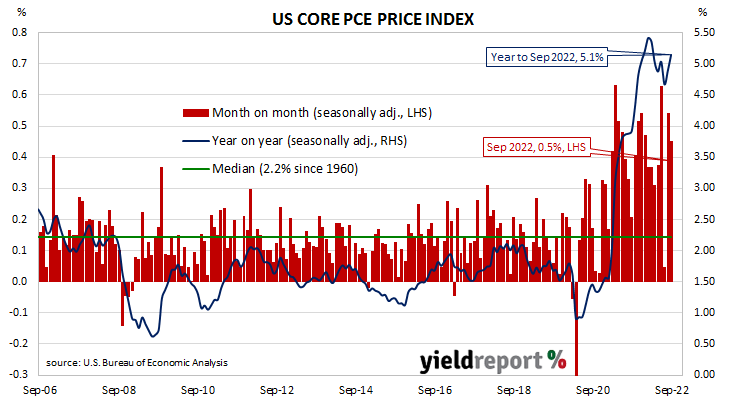Summary: US core PCE price index up 0.5% in September, in line with expectations; annual rate accelerates from 4.9% to 5.1%; core inflation rising but at slightly slower rate; Treasury yields up; Fed rate-rise expectations harden.
One of the US Fed’s favoured measures of inflation is the change in the core personal consumption expenditures (PCE) price index. After hitting the Fed’s target at the time of 2.0% in mid-2018, the annual rate then hovered in a range between 1.8% and 2.0% before it eased back to a range between 1.5% and 1.8% through 2019. It then plummeted below 1.0% in April 2020 before rising back to around 1.5% in the September quarter of that year. It has since increased significantly above the Fed’s target.
The latest figures have now been published by the Bureau of Economic Analysis as part of the September personal income and expenditures report. Core PCE prices rose by 0.5% over the month, in line with expectations as well as August’s result after it was revised down from 0.6%. On a 12-month basis, the core PCE inflation rate accelerated from August’s figure of 4.9% to 5.1%.
“Core inflation is still rising but at a slightly slower rate,” said ANZ rates strategist Gregorius Steven.
US Treasury bond yields increased materially on the day. By the close of business, the 2-year Treasury bond yield had gained 11bps to 4.40%, the 10-year yield had added 9bps to 4.01% while the 30-year yield finished 6bps higher at 4.14%.
In terms of US Fed policy, expectations of a higher federal funds rate over the next 12 months hardened. At the close of business, November contracts implied an effective federal funds rate of 3.775%, 70bps higher than the current spot rate while December contracts implied a rate of 4.155%. September 2023 futures contracts implied 4.595%, 152bps above the spot rate.
The core version of PCE strips out energy and food components, which are volatile from month to month, in an attempt to identify the prevailing trend. It is not the only measure of inflation used by the Fed; the Fed also tracks the Consumer Price Index (CPI) and the Producer Price Index (PPI) from the Department of Labor. However, it is the one measure which is most often referred to in FOMC minutes.


